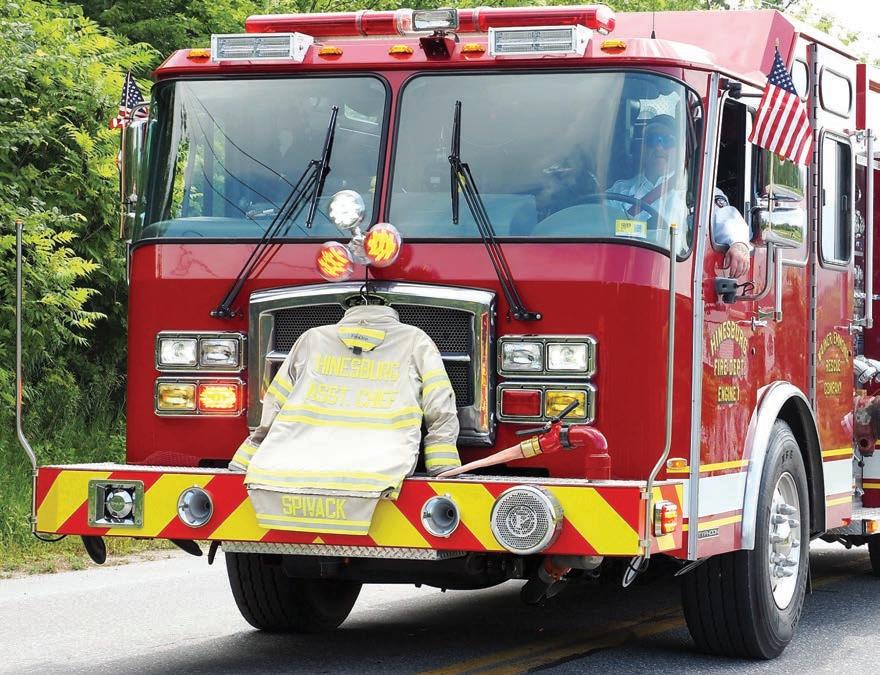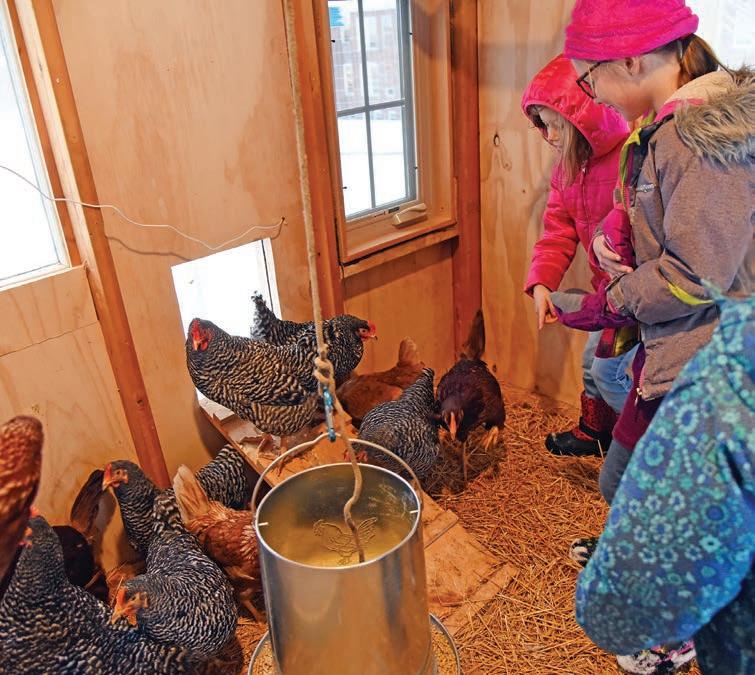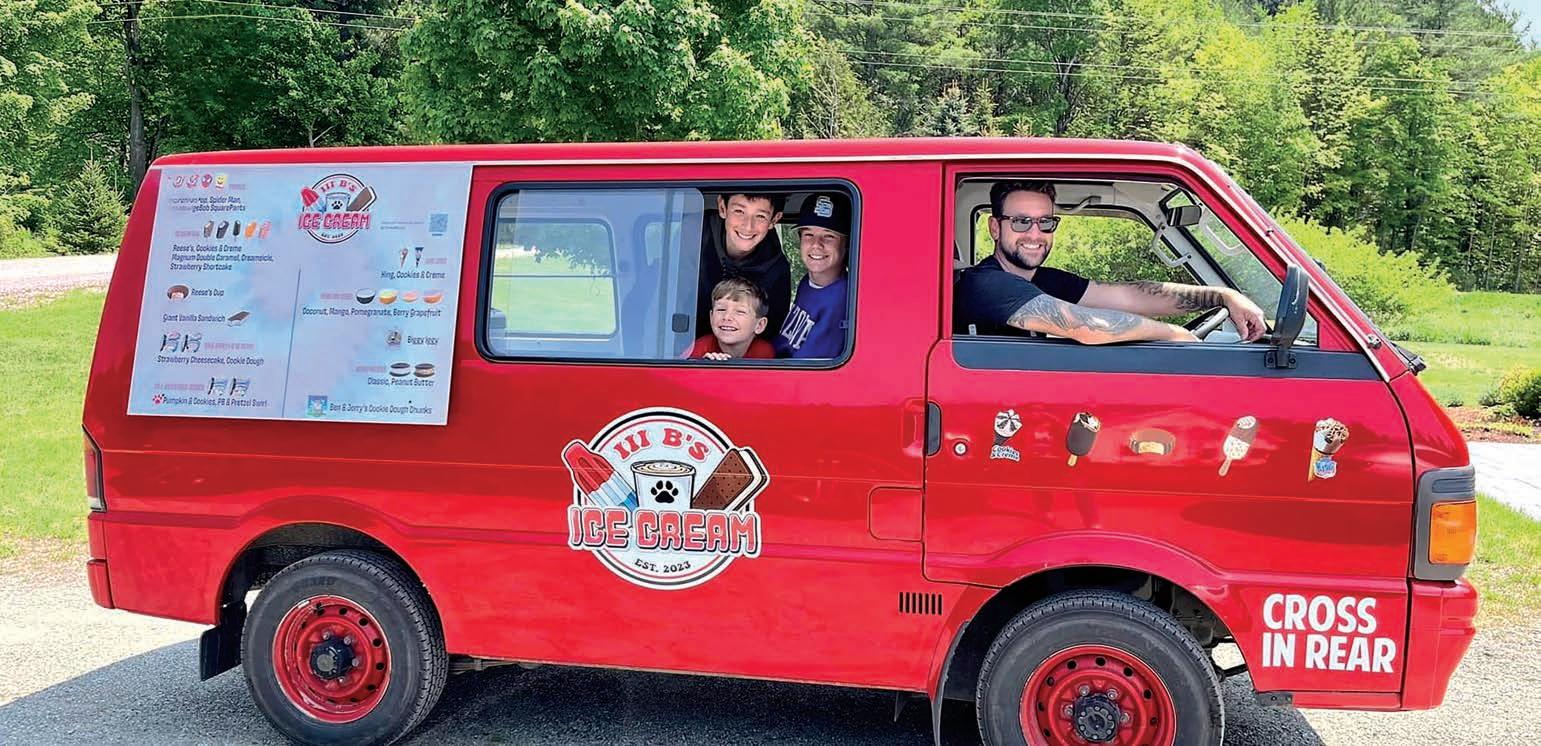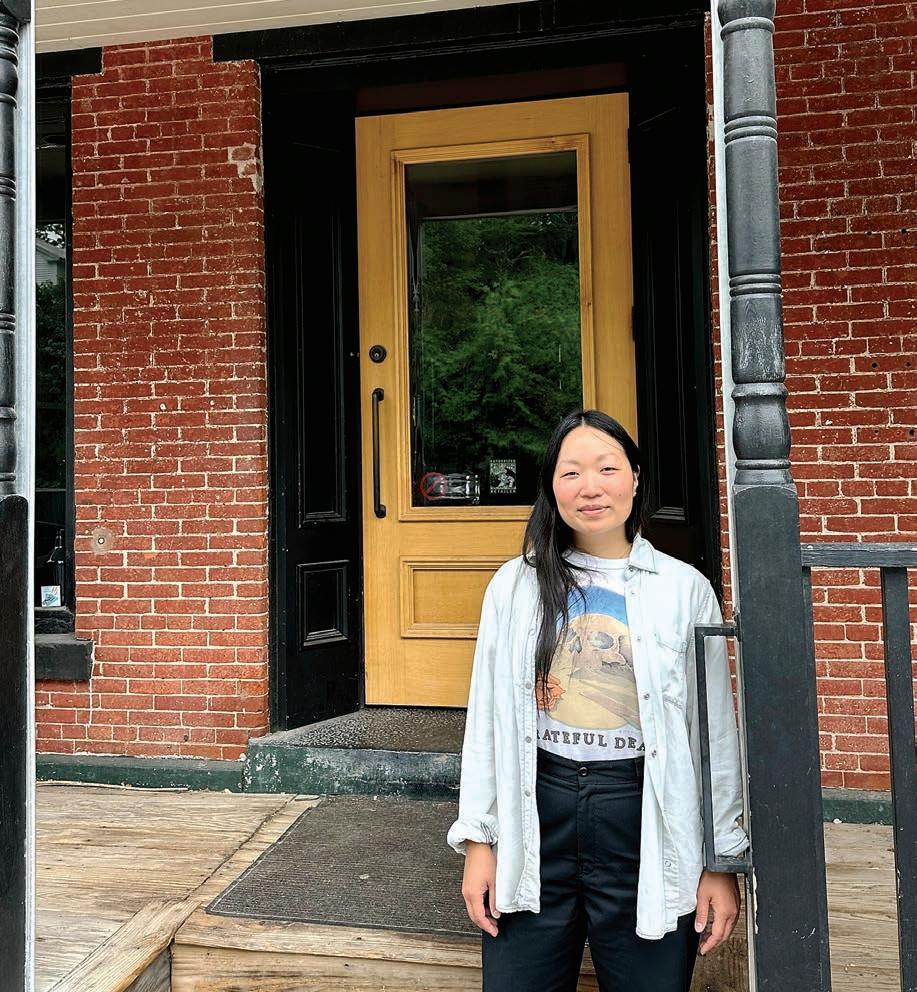Backyard chickens
Vermont health officials explain the risks

Page 3
July 6, 2023


Vermont health officials explain the risks

Page 3
July 6, 2023

Progress in an agreement to share police services between Hinesburg and Richmond resumed following a brief hold.
The inter-municipal agreement originally settled upon in April permitted Richmond to make a request for a Hinesburg officer to respond to calls from Richmond at a rate of $50 per hour or to patrol the town at a rate of $70 per hour but only when the Hinesburg department has the staffing bandwidth to do so.
However, the agreement made to assist the Richmond police department was postponed due to intervention by the local police
‘Golden
Bruce Hill talks about a lifetime on the lake

Page 9
union. The union’s concerns were addressed through negotiation with the town of Richmond, resulting in an adjustment to the wage scale for Richmond police and establishing guidelines for calling in a Hinesburg officer, giving Richmond police priority for overtime work.
Following a meeting with Vermont State Police June 21, the Hinesburg Selectboard said it was negotiating the contract’s length and ironing out dispatching.

“Right now, this contract is of undetermined length, and I think we’ll probably have further discussions depending on Richmond,” Hinesburg town manag-
See POLICE on page 13
From the busy streets of New York City, Jolene Kao and her family came to Vermont for a quieter life surrounded by open spaces, and turns out, that also meant becoming the new owners of The Old Brick Store in Charlotte.
Although owning a place like The Old Brick Store wasn’t originally in the plans, Kao has strong roots in the restaurant industry. Originally born in Dallas to Taiwanese immigrants, she spent most of her upbringing in her family’s generationally owned
restaurant, Rural China.
“We would run around the restaurant and I would make cherry pancakes in the kitchen,” she said. “When I was older, I started bussing and hosting and working the register, placing orders, running payroll and helping my mom do that prepping in the kitchen. But the best was when I was in college, and I would come back to visit and work the line.”
In 2006 she moved to New York to pursue a career in photography but eventually burned out when she realized the pace of the
See STORE on page 12
LIBERTY DARR STAFF WRITERCouple will continue centuries-old tradition at the historic location
Raspberries. Brie. Spinach. Ground turkey. Orange juice.
That eclectic mix is just a sample of Jon Brandom’s early morning grocery haul on a recent Wednesday. He was picking up for Feeding Chittenden, a hunger relief organization based in Burlington that provides meals, a market, cooking classes and more to Chittenden County residents experiencing food insecurity.
UVM researchers estimate that 40 percent of Vermonters experienced food insecurity in 2022. Meanwhile, Feeding Chittenden helps feed more than 12,000 people a year.
“I feel like this is an answer,” Brandom said, as he crisscrossed the Burlington area in a boxy white van.
Brandom, Feeding Chittenden’s food rescue coordinator, makes trips like these five days a week in the Burlington area to grocery stores such as Hannaford, Trader Joe’s and City Market. The stores designate items up for donation with a “Food Shelf” label, and Brandom is left to search fridges and freezers to snatch as much as he can. He begins his day at 8 a.m., and he hopes to bring back fresh produce before the Feeding Chittenden doors open at 9.
Once he scours the shelves, Brandom returns to the organization’s headquarters at 228 N. Winooski Avenue in Burlington to help put away the bounty and set up Feeding Chittenden’s food market — a self-service setup where people who don’t have enough food can get sustenance, no questions asked.
“You get what you want and that’s all that counts,” said a Burlington resident who declined to give her name as she left with a bag of pork, beans and other items. She has been going to Feeding Chittenden since 2004, she said. “It’s a good place to be.”
Brandom’s job is a sliver of the pie at Feeding Chittenden,
where the vast array of offerings separate it from other food relief operations in the area. As one of nine organizations that are part of the Champlain Valley Office of Economic Opportunity, it can offer a wealth of diverse programs to underserved Vermonters.
Its headquarters also house CVOEO’s Community Resource Center, which helps connect people experiencing homelessness to medical, transportation or housing resources, among others.
“What sets us apart is just the variety of programs that we provide. It isn’t just about giving people food there,” Anna McMahon, associate director of Feeding Chittenden, said.
“We’re truly trying to change the way that we’re interacting with marginalized populations so that we can better serve them and trying to continually evolve our programming to better meet the needs of economically disadvantaged Vermonters,” she said. “I think we’re definitely at the forefront of this in Vermont.”
Brandom’s collections are part of the over two million pounds of food the organization procures every year, most of it donated. They are items that have not yet expired and are always safe, but not quite up to snuff to be sold in stores.
For example, many bags of oranges and apples contain only one or two bad ones. The rest of the fruit is usable, but supermarkets ditch the entire bag.
If food does spoil, Feeding Chittenden has an array of trash and compost bins on-site, something Brandom admits didn’t sit right with him when he joined the organization in January.
“I used to feel squeamish about it at first,” he said. “But we’re literally the last possible stop before it gets thrown out.”
A 2016 graduate of the University of Vermont, Brandom said he enjoyed studying sociology because “it felt nice knowing I had answers.” He also majored
in environmental science and analyzed food waste systems and poverty, inspiring him to return to the area in 2020 to pick up where he left off.
He arrived at Feeding Chittenden over five months ago after working for City Market Co-op in Burlington, a major supporter of Feeding Chittenden’s work. He enjoys the physical aspects of the job, carrying boxes of food in and out of trucks and always being on his feet, but admits that it’s “put a dent in my running.”

“I obviously enjoy the aspect of helping people out. That definitely helps me sleep at night,” said Brandom, accelerating through a yellow light — something the self-proclaimed “defensive driver” said he rarely does — to make it back to headquarters before the doors open.
Brandom finishes his day by hitting the road again, this time on the delivery side, handling both emergency and scheduled dropoffs for Chittenden County residents in need — another arm of its work. People in need who leave voicemails and send emails to the organization help him plan out his day. He leads a team of about 10 other delivery drivers who help with smaller food pickups in the latter half of the day.
up food, prepping the kitchen, and filling any other gaps that crop up. That is where most of the donated food Brandom picks up comes into play. McMahon said the organization also purchases items that are less frequently donated, such as milk and eggs, to ensure people have a lot of good choices.
“It’s very important to us that it’s a dignified experience,” said Ansley Laev, volunteer and receiving coordinator. Feeding Chittenden prides itself on being organized, well stocked and an overall welcoming space for people dealing with food insecurity.
Hot breakfast is served every weekday from 9 to 11 a.m. and grab-and-go lunches are offered through the early afternoon. Many people will come in for coffee, eggs, bacon, and other early morning staples and, after eating, leave with items from the food shelf, too. An average day sees between 140 and 200 people come into the facilities.
In our summer music preview, we conflated two different musical offerings and listed the wrong dates and musical acts for SB Nite Out. Here is the correct information:
Concerts are held weekly, on Thursdays, 5-8 p.m., at Veterans Memorial Park, South Burling-
ton, through Aug. 24.
July 6: The Grift
July 13: Grippo Funk Band
July 20: B-Town
July 27: Barbie-n-Bones
Aug. 3: Quadra
Aug. 10: Sticks & Stones
Aug. 17: Neon Ramblers
Aug. 24: A House on Fire
Feeding Chittenden’s flagship program is the market that Brandom stocks, a pick-and-choose setup open Monday through Friday from 9 a.m. to 4 p.m. People can come in once a week and take anything they need, with options ranging from pork to fresh produce to canned applesauce.
More than 160 volunteers help the 18-person staff with stocking shelves, delivering and picking
Feeding Chittenden was launched in 1974 as the Chittenden County Emergency Food Shelf but rebranded to its current name in 2019, to indicate it was offering broader services. It has relocated twice over the years, most recently in 1994, expanding all facets of the operation in response to a growing need for food relief.
“It’s all exciting, you know. We’ve continued to innovate and we’re not stagnant,” McMahon
said. “We’re not just doing the same-old-same-old over the last nine years that I’ve been with the organization.”
Part of that development has been its Community Kitchen Academy, where chefs train aspiring culinary artists, helping both in and out of the kitchen with reading over resumes, interview prep and, of course, foodbased training. The meals they prepare are made exclusively with donated food, giving the chefs a chance to showcase their creativity and make recipes on the fly. Their creations are served to residents both on-site and, historically, out of Feeding Chittenden’s food truck — a COVID-19 casualty that McMahon said will be back on the road soon.
Nearly 300 people have graduated from the Community Kitchen Academy since 2009, and Feeding Chittenden says 91 percent of them found jobs in the food industry.
Feeding Chittenden has also grown to help people who are not onlyu experiencing food insecurity, but face access barriers to food pantries or other meal sites.
“We’re really trying to reduce those reasons why people aren’t coming in to get food,” McMahon said, “whether that’s transportation or stigma or a language barrier.”
“It’s sad when organizations like this have to exist,” she said. “We used to say, ‘Oh, we hope to work ourselves out of a job.’ But that just doesn’t really seem feasible at this point.”
“It’s very important to us that it’s a dignified experience.”
— Ansley Laev, Feeding Chittenden
As egg prices have soared, Vermonters may have more reasons than one this year to take a crack at raising backyard chicks.
“Raising baby poultry like chicks, ducklings and goslings in your backyard can offer many benefits, such as fresh eggs, opportunities to connect with nature, and education for children and families,” Dr. Natalie Kwit, Vermont’s public health veterinarian, said. “But it’s very important to take steps to help minimize the spread of diseases.”
According to health officials, chickens can pose risks to human health, sometimes spreading harmful bacteria such as salmonella, campylobacter and E. coli through their meat or eggs, or propagating viruses like avian influenza, also known as bird flu.
As families begin to welcome new flocks this year, officials say it’s important to know how to do so safely.
Infected birds can transmit bird flu viruses through their saliva, mucus and feces, according to the federal Centers for Disease Control and Prevention. Human infection with such viruses, while rare, can occur if these substances are introduced to the human body through a person’s eyes, nose or mouth, or through inhalation.
“Illness in humans from bird flu virus infections have ranged in severity from no symptoms or mild illness to severe disease that resulted in death,” the federal agency reported.
The bacteria and viruses from poultry are most likely to cause severe illness in people with weakened immune systems, older adults and children younger than 5 years old, Kwit said.
To prevent the spread of disease from backyard chickens, the Vermont Department of Health and Centers for Disease Control offer several recommendations — supervise children around poultry, avoid touching the face or mouth after handling poultry or eggs, and make sure anyone who handles poultry or eggs washes their hands thoroughly afterward.
“It’s really helpful to have adults supervise children, especially young children,
for handwashing,” Kwit said, since kids are typically “not as good at hand hygiene as adults are, and will put their hands in their mouths more often.”
The Department of Health also recommends cleaning chicken coops and equipment thoroughly and regularly, and keeping all equipment used to care for poultry — including shoes that people wear near the coop — outside of the house and far away from areas where human food is prepared. Equipment such as cages and food or water containers should always be cleaned outside with a hose, rather than in a kitchen sink or bathtub indoors.
“One of the main purposes that people keep backyard flocks is so they can have fresh eggs,” Kwit said, “and there are certain ways to minimize the risk of exposure to harmful bacteria through handling those eggs and cooking with them.”
Cleaning chicken coops often and collecting eggs regularly help to ensure that bacteria does not build up on shells over time, Kwit said. When preparing eggs to eat, don’t wash the eggs with water, as bacteria can sometimes enter eggs through their porous shells, but instead use a brush to gently sweep debris off eggs. Refrigerating eggs and cooking them fully are other ways to minimize risk of bacterial infection, she said.
“If you keep your animals healthy, you keep the people who own them healthy as well,” Kwit said.
Officials at the Vermont Agency of Agriculture, Food and Markets say that one of the best ways to keep poultry healthy is to prevent contact between chickens and wild waterfowl, such as ducks, which often carry avian influenza.

“Anyone involved with poultry production — from small backyard coops to large commercial producers — should review their biosecurity plans and activities to ensure the health of their birds,” officials at the agriculture agency said.
Raising chickens “really is a fantastic thing — and more popular these days, especially in smaller states like ours — that can really connect people with the environment,” Kwit said, “We just want people to do it safely.”
The much awaited and highly anticipated Pêche Medical, owned and operated by Kellie Malaney, PA and Sarah Dietschi, NP is now seeing patients. Known for their ability to listen carefully and execute a natural-looking, “un-done” appearance, Kellie & Sarah are two of the most experienced, respected and appreciated clinicians in the Medical Aesthetic field in Vermont. Come see them for a consult or treatment and see the difference that experience, artistry and integrity makes!


Schedule online or by phone today!



Researchers from the University of Vermont and Dartmouth College are seeking help from anglers this summer for a survey to measure mercury concentrations in Lake Champlain sport fish.
This survey is conducted every five years in collaboration with the Lake Champlain Basin Program. While numerous fish muscle samples were collected in summer 2022, additional samples are needed for walleye and lake trout.
The data collected will help scientists study the impact of

changing environmental conditions on mercury levels in fish. The information also will be shared with consumers to help them make informed choices as eating too many lake-caught fish with high mercury levels may result in neurological damage. Information about the study can be found at go.uvm.edu/hginfish. The website lists the number and type of samples needed from various sections of the lake along with local markets, bait shops and marinas that have agreed to serve as fish muscle sample collec-
tion sites. Anglers may drop off samples during a venue’s regular operating hours.


Each sample must include a 1-inch by 1-inch fish muscle sample (cut from the thicker end of the fish fillet), the species, length and weight of the fish and the date and segment of the lake where the fish was caught. Each collection site will have project flyers for anglers to record this information along with freezer bags for samples.
For questions about the study, email hginfish@dartmouth.edu.




Please do not place mulch, topsoil or rocks in contact with your meter. Be careful when mowing and report any damage. If your meter is located where large objects, such as vehicles or dumpsters, could collide with it, a barricade should be installed. Contact us about barricade options at 802-863-4511.

During summer, you may see VGS representatives outside your home inspecting our system and painting meters.










Smell: Natural gas is normally odorless. A distinctive, pungent odor, similar to rotten eggs, is added so that you will recognize it quickly.
Sight: You may see a white cloud, mist, fog, bubbles in standing water, or blowing dust. You may also see vegetation that appears to be dead or dying.
Sound: You may hear an unusual noise like a roaring, hissing, or whistling.
Move immediately to a safe location. Call VGS at 800-639-8081 or call 911 with the exact location. Do not smoke or operate electrical switches or appliances. These items may produce a spark that might result in a dangerous condition.
Do not assume someone else will report the condition.
June 26 at 12:39 p.m., police arrested Dustin Benoit, 28, of Hinesburg, for driving under the influence of intoxicants after being called to a
single-vehicle accident scene on Dorset Street in Charlotte. Benoit’s 2022 Dodge Ram was fully engulfed in flames.

Serving the community of Charlotte & Hinesburg
A publication of Vermont Community Newspaper Group LLC thecitizenvt.com
Advertising Wendy Ewing wendy@shelburnenews.com (802) 985-3091 x12
Advertising Director Judy Kearns judy@otherpapersbvt.com (802) 864-6670 x21
News Editor Tommy Gardner
Staff Writers Aaron Calvin Corey McDonald Liberty Darr
Production Manager Stephanie Manning stephanie@shelburnenews.com
Editor/Publisher Gregory Popa gpopa@stowereporter.com

Billing inquiries Leslie Lafountain leslie@stowereporter.com (802) 253-2101

Advertising submission deadline: Friday at 5 p.m. advertising@thecitizenvt.com classifieds@thecitizenvt.com
Editorial submission deadline: Friday at 5 p.m. news@thecitizenvt.com
Calendar submission deadline: Friday at 12 p.m. news@thecitizenvt.com
Contact: 1340 Williston Road South Burlington, VT 05403 (802) 985-3091


As I thought about what the 4th of July meant to me this year, I had to dig deep.

The unelected ultra conservatives who have hijacked the Supreme Court and overturned Roe v. Wade with the help of an impeached and indicted former president have now voted to overturn affirmative action in higher education, to allow businesses to discriminate against LGBTQ customers and to block student debt relief for
millions of struggling Americans.
In moments like this, I am reminded of James Baldwin’s poignant words: “I love America more than any other country in the world and, exactly for this reason, I insist on the right to criticize her perpetually.”

While this past week revealed some of our darkest, most unprecedented days in our democracy, we still have the power to dissent. We can and we must.
As Justice Ketanji Brown Jackson wrote in her dissent on the court’s affirmative action ruling, Students for Fair Admissions v. UNC: “With
let-them-eat-cake obliviousness, today, the majority pulls the ripcord and announces ‘colorblindness for all’ by legal fiat. But deeming race irrelevant in law does not make it so in life.”






And Justice Sotomayor laid out the stakes in her dissent on LGBTQ equality, 303 Creative LLC v. Elenis: “The Supreme Court of the United States declares that a particular kind of business, though open to the public, has a constitutional right to refuse to serve members of a protected class,” Sotomayor wrote. “The court does so for the first time in its history.”
While the Supreme Court is

John
McClaughryThe Legislature’s enactment of the Community Resilience and Biodiversity Protection Act is another troubling example of how massive changes in Vermont are being engineered these days, whether the democratically elected governor likes it or not.
This measure (Act 59) establishes state goals of conserving 30 percent of the land of the state by 2030 and 50 percent by 2050. It requires the Vermont Housing and Conservation Board to develop an inventory of the existing conserved lands and a plan on
how to reach the ambitious goals.
The new law defines conserved lands as enjoying permanent protection of intact and connected ecosystems — to put it crudely, “Humans. Out.”
Gov. Phil Scott vetoed the bill last year but this year, facing a veto-proof Democratic Legislature, he allowed the bill to become law without his signature.
Let’s look at some recent history.
When Scott took office in 2017, he pleased the climate change advocates by creating a Climate Action Commission. To the dismay of the advocates, his commission stopped short of recommending their heart’s
desire, a carbon tax. When it became apparent that Scott would be easily reelected (as he has been three times so far), the climate advocates conceived a new Bypass Scott strategy.
First was the Global Warming Solutions Act, which replaced a CO2 emissions reduction goal with an enforceable mandate. It also created a climate government within the government. The 23-member Vermont Climate Council has 15 members appointed by the Legislature, 14 of which could drive climate policy making, outnumbering Scott’s eight statutory members.
Scott vetoed the act as an unconstitutional violation of
the separation of powers. The Legislature overrode his veto. In December 2021 the climate council issued its sweeping 265-page Climate Action Plan. When the multistate Transportation and Climate Initiative gas and diesel fuel tax plan collapsed, climate council’s top priority became the enactment of a Vermont-only clean heat standard.
That bill required the three-member Public Utility Commission to design and carry out a complicated scheme to make heating fuel customers pay higher prices to subsidize conversions to electric heat pumps and advanced wood heat. The governor vetoed the clean heat standard
Rob Roper
In the wake of the U.S. Supreme court case, Carson v. Makin, which ruled states such as Vermont that have publicly funded school choice programs cannot discriminate against religious schools, the conglomeration of public-school special interests made up of the teachers’ unions, superintendents, school boards, etc. — collectively known as The Blob — finally sees its chance to snuff out all its independent school choice competition.
The Blob is banking on the idea that Vermonters would rather eliminate all school choice in Vermont than allow some — any — parents to choose to send their kids to a religious school with taxpayer dollars.
WCAX did a story June 15 that discussed the issue, noting that the Education Equity Alliance (what The Blob understandably prefers to call itself), “supported legislation that would have met the Supreme Court standard by eliminating private school choice, except at the four historic academies — St. Johnsbury, Lyndon, Burr and Burton and Thetford — which operate as de facto public schools.” That last point is not exactly accurate, but we’ll let it go for now.
The piece stated in apparent support of The Blob’s position that, “Through a public records request, we learned that at least 53 students enrolled in these
religious high schools (now) have their tuition paid with public dollars, at a total cost of almost $600,000,” adding here a rather snarky “cha-ching” sound effect over the video, presumably to underscore the notion that this is an expensive policy.
But let’s look at those numbers for just a second.
The sum of $600,000 divided by 53 is $11,320 per kid. The average per pupil spending in Vermont’s public schools is $25,053, according to the National Education Association’s calculations.
So, by choosing to send a child to an independent religious school, parents are saving Vermont property taxpayers on average $13,733. That is, shall we say, quite a bit.
Any and all cha-chings here fully accrue to the taxpayers’ benefit.
For a more specific example, the towns in Grand Isle County and Georgia of Franklin County in the northwest corner of the state are all tuition towns, meaning they enjoy school choice. Many parents choose to send their kids to the public South Burlington High School. The cost to do that for the 2023 school year is $17,378 per student.
However, for the families who choose Rice Memorial High School, a Catholic school in Burlington, which is now an option following Carson v. Makin, the tuition cost to taxpayers is $12,900. Not as much savings as the averages, but still a lot.
Certainly, worthy of a cha-ching for the property taxpayers of Grand Isle and Georgia.
Education, of course, is not just about money. It’s also about the quality of programs provided and student outcomes. So how do the religious schools stack up in the results column?
Sticking to the Rice example, according to its website, “Rice has 13 Honors classes and 15 AP classes accessible to all students. Rice is the only school in Chittenden County offering the prestigious Advanced Placement Capstone Diploma.” Rice students have average SAT scores that are more than 20 points higher than the state average, and 90 percent of graduates matriculate onto college.
More generally, an Oct. 27, 2022, article in the Wall Street Journal analyzed the most recently published National Assessment of Educational Progress scores and concluded, “Today, the divergence between Catholic schools and public ones is so great that if all U.S. Catholic schools were a state, their 1.6 million students would rank first in the nation across the NAEP reading and math tests for fourth and eighth graders.”
This is not a case of wealthy elites sending their children to exclusive private schools. Catholic schools are overwhelmingly lower cost than most private schools, and more economically diverse than public schools that restrict student access according to zip code, segregated based on property value. Let’s not forget that when COVID-19 hit, it was the Catholic schools that were the first to pay attention to the accurate science and re-open for in-person learning — a decision that put the best interests of students and families first.
as a disguised carbon tax, which it was. The House sustained his veto by a single vote in 2022.
This May the Legislature enacted the Council’s clean heat standard plan, relabeled the Affordable Heat Act, over Scott’s veto. The act assigned its implementation not to the Scott administration, but to the Public Utility Commission, chaired by a climate change alarmist who has put decarbonization ahead of the commission’s historic job of protecting gas and electricity ratepayers. The $2 billion-plus clean heat standard program was thus located largely beyond the governor’s reach.
As such, if you were a Catholic school kid during the pandemic, you didn’t suffer two years of learning loss like your publicschool counterparts did.
Catholic schools also tend to attract more racially diverse student bodies as a disproportionate number of immigrants from dominantly Catholic Latin American countries, and African countries such as Nigeria, Uganda and Tanzania gravitate toward Catholic schools for their children. Therefore, it is more than a bit ironic that the opponents of school choice cite anti-discrimination as a primary motive behind their desire to discriminate against religious schools and the families that would attend them.
A Catholic education may not be for everybody, and the beauty of a school choice system is that it doesn’t have to be. If you prefer drag queen story hour to a prayer before meals for your child’s upbringing, you have your pick of institutions. After all, those folks in Grand Isle and Georgia can choose South Burlington High School, Milton, Bellows Free Academy or anyplace else that makes the most sense for them.
But when lawmakers move to take those choices away and make decisions for others’ children that rightly should be made by parents, they are doing damage to families, students and, as shown above, to taxpayers. They do this for the purpose of satisfying their own anti-Christian prejudices or to pay off the politically powerful, special interest public education Blob.
Not the most noble of motivations, for sure.
Rob Roper is a freelance writer who has been involved with Vermont politics and policy for over 20 years. He lives in Stowe.
The principal clean heat standard default delivery agent for clean heat credits will be Efficiency Vermont, controlled by the nonprofit Vermont Energy Investment Corporation. The chair of the corporation is Richard Cowart, creator of the clean heat standard plan and a legislatively appointed member of the Vermont Climate Council.
The Community Resilience and Biodiversity Protection Act of 2023 will lay the groundwork for the coming comprehensive state land use control system. Its aim is to conserve 50 percent (4,800 square miles) of Vermont from humans meddling with ecosystems. That will diminish if not confiscate the rights of thousands of private property owners. It will be designed and possibly implemented by the government-funded Housing and Conservation Board. Four of its 11 members were appointed by the governor, and none of them are directly accountable to the people of the state.
Let’s concede that the Public Utilities Commission and the Vermont Housing and Conservation Board do some useful things. The underlying question is: what accountability do these organizations have to the elected governor? For comparison, if the Agency of Transportation messes up plowing the state highways, that will blow back onto the governor.
But the powerful, well-funded environmental organizations, employing (at recent count) 42 lobbyists in Montpelier, have persuaded the Democrats in the Legislature to implement far reaching state policies — on the climate crisis, land use, ecosystem protection and the rest of their list of fashionable progressive causes.
This is where the Bypass Scott strategy has taken us.
The governor still has resourc-
Peter Shea
Here’s a clarion call for all Vermonters who like to fish or anybody, for that matter, who enjoys a day on a healthy lake.
Wake boats are large vessels powered by 500 horsepower engines. They take on water ballast to submerge the stern. These features allow the craft to produce wakes four feet or greater for the benefit of rope-less wake surfing. Good fun for the few who can afford the $100,000-plus price tag. But bad for just about every other user of Vermont’s public waterways, especially those out to enjoy a day’s fishing.
Anglers are especially encouraged to scrutinize this new product from the power sports industry, which in my opinion is the single driver of getting these rigs on our waters. These boats are detrimental to angling interests on two fronts: environmental and enjoyment of time spent fishing.
Wake boat’s propulsion creates a strong, downward thrust. In shallower waters, this disturbs lake-bottom sediments. These shallower regions are the nursery of all that lives in our lakes and ponds. The shallows are the nursery for juvenile fish. They are the home of mayflies, dragonflies and other bugs critical to the food chain. Wake boats, left unregulated, will upset this fragile and critical habitat.
Lake bottoms are also host to nutrient-rich materials deposited over hundreds, even thousands, of years. When disturbed, these
MCCLAUGHRY
continued from page 6
es to slow down or thwart the climateers. But at least in this important sector of state policy making, he is no longer the policy leader who wins elections by delivering on proposals attractive to a majority of voters.
HINSDALE
continued from page 5
attacking racial justice, equality and access to higher education, the vast majority of Americans disagree. We are in a fight for the soul of this nation, and fundamentally, what it means to be American and what kind of country our children will inherit. This is not a fight we can give up, nor can we afford to lose.
nutrients, which include phosphorus, enhance algae blooms. These problems have already degraded many Vermont waterways. Large wakes also cause shoreline erosion, contrary to the goal of the 2014 Shoreline Protection Act passed by our Legislature to protect shores and water quality.
The Vermont Department of Environmental Conservation is spending millions of dollars today attempting to reduce waterborne phosphorus levels, which are rising in many of Vermont’s more pristine lakes. It employs an army of scientists — at taxpayer expense — to curtail pollution in public waterways. Does it make sense to permit wake boats contrary to public interest?

From an angler’s viewpoint, wake boats are a two-edged threat. One is the harm to fishery and aquatic habitat. The second is a collision of recreation interests: wake boats and their 4-foot waves versus the angler who customarily is a tranquil presence enjoying their sport. Large wakes pose a safety threat to small craft like kayaks, canoes and small trolling skiffs. Who wants to go fishing when you are rocked by waves larger than any ever experienced in a pond or lake’s history?
Predictably, when wake boats commence operation most other waterbody users — anglers included — will retreat.
Must the Vermont public embrace every new product produced by the power sports industry? It’s doubtful that there are a half-dozen people in the state that are even interested in getting one of these rigs, and it’s likely all of them can afford a real
surfing safari, rather than muck up our waters. How can all the environmental pitfalls that these serve up possibly be trumped by what is not even a mild public clamor for them? Besides “the industry” who wants them?
The Department of Environmental Conservation has been petitioned by a citizens’ group responsiblewakes.org to restrict wake boat operation 1,000 feet from shore in waters 20 feet or deeper. Some 16 Vermont lakes would qualify. The Department has proposed a more moderate rule — 500 feet from shore, 20 feet deep or more. This version includes 40-plus lakes and ponds in Vermont. Of course, neither version recognizes the reality that whatever limit is set, it is likely to be violated repeatedly and routinely.
Many critics, and that includes me, would welcome an outright ban on wake boats. I cannot
grasp how we’ve come to have to decide between bad and really bad.
That said, anglers are encouraged to get educated about this new class of vessels and to participate in the state rule making,
which is now underway. Learn more at dec.vermont.gov/watershed/lakes-ponds/rulemaking.
Peter Shea of Burlington is a Vermont angler, geographer and outdoor author
What the people want, how much they are willing to pay for it in tax dollars, how many rights are they willing to see abridged, and who will be held democratically accountable when the show slides off the rails, is of concern
to a governor facing reelection. For the Bypass Scott crowd, not so much.
John McClaughry is the vice president of the Ethan Allen Institute.
Local businesses and restaurants need your support more than ever. Whether you visit stores, get delivery or shop online, keep your spending local and keep your community healthy.
Newspapers are LOCAL. We are dedicated to keeping you informed, safe and connected and care about the issues that are important to our neighbors, our schools and our businesses.
Local businesses and restaurants need your support more than ever. Whether you visit stores, get delivery or shop online, keep your spending local and keep your community healthy.
After this 4th of July, I hope you will join me in loving this country enough to openly criticize those who would tear down the promise of liberty and justice for all. We must ensure government reflects the will of the people before it’s too late. We must dissent.
Happy Independence Day.
Kesha Ram Hinsdale, a Democrat from Shelburne, serves the towns of South Burlington, Shelburne, Charlotte, Hinesburg, Milton, Burlington, St. George, Westford, Underhill, Jericho, Richmond, Winooski, Williston, Essex and Bolton in the Legislature.
When you support your local newspaper, you support your community. SUPPORT
Newspapers are LOCAL. We are dedicated to keeping you informed, safe and connected and care about the issues that are important to our neighbors, our schools and our businesses.
When you support your local newspaper, you support your community.
Surely the manufacturer of this little red van did not expect it to be used like this.
After somehow making its way across the Pacific Ocean, the van landed in Pennsylvania, where it was sold to a dealership in St. Johnsbury. Now, the vehicle that was once employed as a Japanese fire truck treks through
Vermont’s residential roads — capturing attention of kids and adults alike through its unique look, as well as the island jams echoing from of its windows.

“We pull into a development, we turn up the reggae, and we roll through at about two miles an hour,” Josh Leggett said. “It’s been quite a scene.”
Leggett and his family set out for the van’s maiden voyage on Memorial Day weekend — ready
to roll out for its new purpose: selling ice cream.
With Josh and his partner, Renee, and their three kids — Sawyer, Shamus and Sebastien — out of school for the summer, they saw a perfect opportunity to start a roving family-run enterprise.

“It’s been fun and interesting, and the best part about it is we can all fit in the van,” he said. “It’s been a really great experience.”
Josh grew up in Hinesburg, where he helped his father and grandfather run Ballard’s Corner Store on the corner of Route 116 and Shelburne Falls Road before it was sold to Jiffy Mart.
“I’ve been kind of in that food industry for a while and I’ve always wanted to have a food truck,” he said. He originally envisioned a wood-fired pizza truck but was hesitant to commit to what would have been a major investment.
“We had been looking for a bit and I said, ‘Let’s go with an ice cream truck to start,’” he said.
The truck appeared out of the blue. Renee’s cousin who works at the dealership in St. Johnsbury queued the van up for a camper, but those plans never panned out. So, the family bought the van and threw a cooler into the backseat.
With only 6,000 miles on it, the truck is in great shape.
“It’s a great rig — the motors in great shape, the body is in great shape,” Leggett said. “It’s a good fit.”



The business has gotten off to an excellent start. They’ve been made a preferred vendor with the South Burlington Recreation Department, getting access to all its events through the summer,
and people have reached out for private birthday and graduation events.
The family has also worked Underhill’s food truck night on Fridays, among other events.
The ice cream truck was at South Burlington’s Dorset Park on June 24 for the city’s Camp Out in the Park event and worked in Williston for the town’s Fourth of July parade.
Both Josh and Renee work full-time, so the ice cream truck remains a weeknight and weekend operation.
But it stays flexible, they said, and they can pick and choose what events they can do.
They also do door-to-door sales as well and have made their way through South Burlington and Williston among other communities — surprising, perhaps, for folks who may visualize a classic white truck playing jingles when they think of an ice cream truck.
“It’s a different vibe than the Mr. Ding a Ling piece,” he said. “We carry around reggae music on our speaker and just kind of put the island vibes in. We’re just trying something a little different,” Leggett said.
“It’s a new school vibe to an old school tradition.”
“I said, ‘Let’s go with an ice cream truck to start out with.”
— Josh Leggett
“I have a lot of good memories about Golden Dazy. That was my high point in sailing,” recalled 90-year-old Shelburne resident Bruce Hill as he pointed to the replica of the sailboat hanging on the wall of his lakeside home.
Hill has lived in town for nearly 55 years, hailing from Long Beach, Calif., and although he may not consider himself a natural-born thrill seeker, his life story is seeping with tales of sea adventures, races against time and having the courage to strike out on new endeavors.
During his time on the Golden Coast, he worked for an engineering company called Autonetics. He later moved to South Burlington to work at GE, and five years later he transferred to the new IBM plant that was being constructed, but his time there was cut short just shy of a decade when his old sailing friend called him with an exciting proposal that would change the course of his life forever.
“One of my sailing friends (Steele Griswold) bought the Shelburne Shipyard and he needed a manager for this new business that he owned,” Hill explained. “I’d been one of the crew on his sailboat and he asked me if I’d like to change jobs and become the manager. I gulped and I thought to myself, ‘I’ve got a pretty nice corner office at IBM and it’s a good place to work,’ but I ended up accepting his offer.”
After a year as manager, he jumped into the role of a salesman.
“I remember dad worked at IBM and he sold boats on the side of Route 7 and there would be three beautiful brand-new sail-



boats right on the side in a patch of dirt,” his daughter Mary Hill said. “On the weekends, he would meet people there, but he was still working at IBM at the time. It was kind of a joint venture with this friend of his but it also kind of allowed him to get his toes in the water to see what he liked.”
Hill always had a love for sailing open water, even more so when he moved to the Lake Champlain area and joined a local boat club where he learned to race star boats.

“We had a group of people, several of them were working at GE, and we belonged to the Mallets Bay Boat Club, which was a I guess the thing that got me really started enjoying sailing and sailboat racing,” he said.
He recounted stories from six different trips he took racing from Newport, R.I., to Bermuda with the last boat he owned, Golden Dazy — a well-known boat that won Canada’s Cup for the U.S. in 1975 before he owned it.

For the races to Bermuda, “Steele was the captain, and I was the navigator,” he said. “That was an exciting step up in comparison to Lake Champlain.”
His expertise in navigating is mostly thanks to his time spent in the U.S. Navy immediately after high school.
“The third year as a midship-





man was a battleship trip,” he said. “So, one of those courses was a section on how to learn to navigate and it was something that stayed with me. That carried over to my boating days, too.”
With a deep knowledge of boats and years of experience working in sales at the Shelburne Shipyard, by the late 1970s Hill was ready to begin his own adventure: Bruce Hill Yacht Sales, a thriving business that has now been taken over by his son, Jeff.
“He was a good sailor and he liked it and had all the information. I think it was a natural thing for him to progress in, so he took (the business) over and has done a great job,” Hill said of his son. “It kind of surprised me he kept the name, Bruce Hill Yacht Sales, but that’s worked out all right for him — and me,” he said with a smile.
Mary remembers when her father started the business and said growing up on the lake was an integral part of her childhood.
“I was sort of joking to dad that part of why I always wanted to go help was because mom would come home for lunch and then all three of us kids could go swimming,” Mary said. “It was like ‘OK, what can we do to help her so we can go swimming?’”
Hill enjoys being on the lake mostly for the peace and serenity
it has brought to his life, and no matter how difficult things got, the lake was always there to take some of the load off.
“I guess you it’s one of those things you don’t know you like it until you try and have an opportunity to get out of the water. It’s peaceful and quiet and it can be very pleasant,” he said.
Exactly how did he make all the magic happen? For Hill, the






secret recipe is simple: good friends, good luck and, of course, the Lake.
“I was lucky to have somebody who helped me and this relationship with the Griswold Co. allowed me to set up the business. I was lucky enough to even start a business that I knew something about. And, we’re lucky that we have Lake Champlain right next door to us.”


There is really only one certainty in this life: death.
For most people, that word conjures a slew of unsettling emotions, mostly associated with grief and fear, but Shelburne resident Nick Marconi is encouraging people to instead approach their inevitable fate with positive curiosity.
Calling all Charlotters! It’s a neighbor-to-neighbor gathering at Charlotte Beach, Saturday, July 8, for the annual beach party barbecue and potluck.

Enjoy Misty Knoll chicken, Fat Cow Farm burgers, Stones Throw Pizza, Stoney Loam Farm greens, Backyard Bistro gelato, Adams Berry Farm fruit ices, and live music and entertainment by the Hokum Bros.

Grilling will be overseen by Fortin’s Lawncare & Snowplowing.
Bring your own plates, utensils, chairs and blankets and beverages. Dinner will start at 6 p.m. but arrive early to include your dish for the potluck. No potluck, no problem. Consider a donation to the party fund on the day.
The rain date is Sunday, July 9. Questions? Email or text Bill at 802-343-4350.
The Age Well meal pickup for Thursday, July 6, is from 10 to 11 a.m. at the Charlotte Senior Center features barbecue chicken breast, baked beans, cauliflower with chives, wheat bread, strawberry shortcake with cream and milk.
You must pre-register by the prior Monday at 802-425-6345 or meals@charlotteseniorcentervt. org.
The meal on Thursday, July 13 features cheese tortellini with alfredo, peas and carrots, spinach, wheat bread, watermelon and milk.
The meal on Thursday, July 20 features beef steak with mushroom sauce, mashed potatoes, broccoli florets, wheat roll, pump-
kin and white chocolate chip cookie and milk.
The suggested donation is $5. Check the website for last-minute cancellations at bit.ly/3FfyLMb.
July Grab and Go meal
Age Well and St. Catherine’s of Siena Parish in Shelburne are teaming up to provide a meal to go for anyone age 60 and older on Tuesday, July 11.
The meal will be available for pick up in the parking lot at 72 Church St. from 11 a.m. until noon and are available for anyone 60 or older. Suggested donation is $5.
The menu is cheese tortellini with alfredo sauce, peas and carrots, spinach, wheat bread, watermelon and milk.
To order a meal contact Kathleen at agewellstcath@gmail.com
or 802-503-1107. Deadline to order is Wednesday, July 5. If this is a first-time order, provide your name, address, phone number and date of birth.
Cassandra Guillemette of Hinesburg, a student at Center for Technology in Essex Junction, was awarded the high school gold medal in dental assisting at the 2023 SkillsUSA Championships.
More than 6,000 students competed at the national showcase of career and technical education. The SkillsUSA Championships is the largest skill competition in the world and covers nearly 31 football fields.
A total of 1,250 gold, silver and bronze medals were presented to students on June 23 at the awards session.
bounce around ideas about some of life’s greatest unknowns: What is on the other side? Is it painful? Why are we so afraid of it?
Since 2014, he has helped facilitate and host a series of death cafes in Burlington — and now, in Shelburne — as a way for people to openly discuss their experiences and examine some of the root causes of why many people fear the topic of death and, more important, why it has become such a taboo discussion point in society.
Surprisingly, he has found that the conversation has a way of forging the unlikiest of friendships.
“To me, talking about death and dying is a very significant subject and experience in our lives,” he said. “I can’t think of anything more significant. If you can really be comfortable, I mean really comfortable, talking about that and going deep with that, it’s going to make the rest of the show more interesting and a little bit easier. Not dealing with it is not helpful.”
The death cafe movement began in London in 2011 with a simple premise: eat cake, drink tea and discuss all things mortality with the hope of encouraging people to make the most of their finite lives. Founder Jon Underwood adapted the idea from the “café mortel” movement that emerged in Switzerland by sociologist Bernard Crettaz. Since that time nearly 16,253 death cafes have sprung up in more than 85 countries.
“We should normalize (talking about death) so that it doesn’t become this freaky, ‘Oh, we don’t want to go there, that’s dark,’” he explained. “But it’s part of the whole existence thing, the living thing. Human beings are aware of that so it really impacts their worldview and the way they view their life.”
The group is far from a grief support group or end-of-life planning group, but more so a casual roundtable-style discussion for people to wax philosophical and
This weekend, a dozen people gathered around the wooden table in Village Wine and Coffee’s gallery room, some Shelburne residents, some out-of-towners and ranging in age from their 80s to mid-30s, all possessing different journeys, but all finding common ground within the conversation.
What’s even more interesting is half of them came into the cafe as total strangers but by the end of the two-hour-long meeting had come to know some of each other’s greatest hardships, triumphs and life stories.
Motives for attendance varied. Some shared stories of loved ones’ passing while others came to playfully banter differing opinions about what is beyond the physical realm. While there were some somber moments, there was also a ton of laughter and fun. The meeting was guided slightly by Marconi, who tossed out a few preliminary questions, but for the most part, conversation ebbed and flowed through a variety of different topics.
For Marconi, who is an optometrist by day and philosophy enthusiast by night, the fascination with mortality started sometime when he was a teenager, and unlike many people, has stayed with him for the majority of his life.
“I have a lifelong interest in the human condition. I mean, that sounds kind of grandiose, but really I started thinking about the whole of what this was all about when I was very young,” he said. “I was a teenager and I never dropped it because I was always interested in talking about death and dying. It’s a natural thing for me.”
There was no great philosophical epiphany at the end of the meeting other than a simple thought that the world might be a better place if more people talked about death together because, as Marconi puts it, that’s what this topic really can do: bring people together.
“People are held by fear around dying and just being able to voice that and share that is unburdening in itself, and then hearing how other people also share in that is really helpful.”


The Champlain Valley All-Stars. Cheering on the parade participants from the sidelines. Troop 690 assembles as the parade gets underway. A patriotic hat. Hundreds turned out for Tuesday’s parade in Hinesburg.



continued from page 1
life she was building was unsustainable.
“In my mind, I was kind of always feeling like maybe I wanted to open my own little food store, not a traditional restaurant, but a place where I can be face to face with people because I think that’s so much of what I loved about growing up in my parents’ restaurant,” she said. “Somebody would come in and they’d bring their baby and say, ‘This is the fourth generation of our family who has come to dine at this restaurant.’ You really develop these relationships with people.”
In 2016 she returned to the restaurant world, this time working as part of the inaugural kitchen crew for a newly opened restaurant in the city.
“It was a great experience. I learned so much and worked even harder, longer days than I had in production,” she explained. “It was hugely influential for me as a culinary experience.”
Finally, after 15 years in the Big Apple, Kao and her partner Pete Macia, along with their daughter, decided it was time for a change and by August 2022 the family officially settled in Charlotte.

“We visited Vermont a few times and our last trip was in
Burlington. Each place, no matter how busy or rural it was, it just felt so good. You just really felt a sense of community around. So when we moved here, we had like this feeling that there is so much support and so much community,” she said.
Apart from the kitchen side of the business, she has additional experience as a co-founder of a woman-in-business nonprofit group based in Brooklyn. And when she found The Old Brick Store, all the puzzle pieces fell perfectly into place.
“I felt like maybe this is the place that I could do it because there is actually a need for more spaces like the one that I’ve been building in my head,” she said. “My dream space was really about bringing community together and having some food that really showcases what is available locally. When I found out that The Old Brick Store was for sale, then that was really the lightning strike of everything where I thought, OK, I think this is the one.’”
Although Kao plans to put a new spin to things, The Old Brick Store possesses its own magic and has been a staple in town for centuries. Variations of the building have come and gone, but the building that now stands was erected in1853.
PUBLIC HEARINGS
Wednesday, July 26, 2023
Please Note: The Charlotte Town Office is fully open to the public for in-person participation at evening meetings. For those who prefer, remote participation is still available online via Zoom. A detailed agenda and how to join this meeting online will be posted by July 11, 2023 at: https://is.gd/Meeting_Calendar_Agendas.
Pursuant to 24 VSA §117 and the Town of Charlotte Land Use Regulations, the Charlotte Development Review Board will hold a public hearing at Town Hall, 159 Ferry Rd. on the following application during its regular meeting of Wednesday, July 26, 2023:
7:05 PM 23-099-SD Kiley – Final plan review for proposed two-lot minor subdivision at 2033 Dorset Street, VT 05445. Application materials will be available at https://tinyurl.com/2m6dyxtn.
For more information, contact the Planning & Zoning Office at 802.425.3533 ext. 208.
NOTICE: Pursuant to 24 VSA §4464, participation in this local proceeding, by written or oral comment, is a prerequisite to the right to take any subsequent appeal. If you cannot participate directly in the hearing, comments may be made in writing prior to the hearing date and mailed to: Planning Office, Town of Charlotte, 159 Ferry Rd., Charlotte, VT 05445, or via email to: pza@ townofcharlotte.com.
“In 1840 to 1850 there were a lot of brick buildings built in town because there was a brickyard and brick oven near the Congregational Church,” Dan Cole, a member
of the historical society said.
Whitney Williamson Finley the proprietress of the store since 2015 could not be reached for comment but did post on social media last month, “Thanks for all the support over the last 8 years.
Shelburne Highway Department Truck Driver/Laborer
The Town of Shelburne has an immediate opening for a teamoriented Truck Driver / Laborer.
This full-time position is responsible for operating trucks and equipment to maintain Town roads and properties and working as a laborer on Town projects. A commercial driver’s license or the ability to obtain one within six months is required.
A complete job description is available at: https://www. shelburnevt.org/237/Human-Resources.
To apply, submit employment application and/or resume to scannizzaro@shelburnevt.org.
Your visits, stories, and laughter have made this job so very rewarding.”
Kao said the sale isn’t finalized until July 14 and the store will remain closed until then to put some finishing touches on both the space and the menu. When asked what new additions customers can expect, Kao didn’t hesitate to say, “a proper coffee program” with specialized espresso drinks.
“Pete and I really love the idea of being a part of history and being the next stewards of this historic place.”
“Pete and I really love the idea of being a part of history and being the next stewards of this historic place.”
— Jolene Kao
If it’s important to you or your community look for it in The Citizen.


continued from page 1
er Todd Odit said at the town’s June 21 selectboard meeting. “If they want a longer contract with defined hours, then we can plan to potentially provide that coverage, whatever it is they need … this is really those initial steps.”

Currently, Hinesburg officers do not patrol Richmond, instead saying they will only respond to calls. Odit said that depending on future data, the selectboard would look into providing additional coverage based on expenses and necessity.
Catherine “Kitty” Gellert Ross, born in Prague, Jan. 26, 1938, died peacefully at home in Manhattan, on Saturday, June 24, 2023.
A devoted mother, grandmother, sister, aunt and friend, Kitty cherished extended conversations, and will be remembered for her one-of-a-kind sense of humor. Her family will miss her. Details of the memorial service will be announced at a later date. Donations in her memory may be made to the Jupiter Symphony, 155 West 68th St., Suite 319, New York, NY 10023 (212-799-1259).
Still, reluctance for the partnership remains following the Hinesburg department’s past issues with staffing. Within four months, the Hinesburg police department went from six to three officers after residents vetoed their police budget in March 2022.
As of now, Hinesburg’s police department has two full-time officers and four who serve part-time.

“I think we’re subsidizing Richmond. They’re not paying benefits, they’re not paying patrol cars and they’re not paying all the basic expenses of a police department,” Hinesburg resident


The Town of Hinesburg, Vermont seeks qualified applicants for the following positions:

• Highway Foreperson
• Highway Maintainer
• Water and/or Wastewater Operator







• Firefighter/AEMT
• General Seasonal Summer Help


Detailed information and an application form can be found at www.hinesburg.org under the employment tab. Applications can be mailed or delivered to Todd Odit, Town Manager, 10632 Route 116 or emailed to todit@hinesburg.org.

The Town of Hinesburg offers a comprehensive benefits package and very competitive pay. We are an Equal Opportunity Employer and women and minorities are encouraged to apply. Applications will be reviewed as received and accepted until the position is filled.
Margaret McNurlan said. “I think regionalization is great, but subsidizing them? Not so much.”

According to the state police contracts, officers will be paid time and a half for service outside
of regular hours, between $50 to $65 an hour, depending on the responding personnel.
“We needed something to start with, but it’s not necessarily going to be this way forever,” Odit said.
Buying and shopping locally helps independent businesses, which in turn helps all of us shape our community’s distinct flavor, personality and character.
The week-long bait drop is a cooperative effort between Vermont and the U.S. Department of Agriculture Wildlife Services to stop the spread of the potentially fatal disease.
100 percent effective when given soon after a person is bitten by a rabid animal.
So far this year, 23 animals in Vermont have tested positive for rabies, and 14 of those have been raccoons.
continued from page 4
Rabies is a deadly viral disease of the brain that infects mammals. It is most often seen in raccoons, skunks, foxes, and bats, but unvaccinated pets and livestock can also get rabies.The virus is spread through the bite of an infected animal or contact with its
continued from page 2
The week-long bait drop is a cooperative effort between Vermont and the U.S. Department of Agriculture Wildlife Services to stop the spread of the potentially fatal disease.
Rabies is a deadly viral disease of the brain that infects mammals. It is most often seen in raccoons, skunks, foxes, and bats, but unvaccinated pets and livestock can also get rabies.The virus is spread through the bite of an infected animal or contact with its
According to wildlife officials, rabid animals often show a change in their normal behavior, but you cannot tell whether an animal has rabies simply by looking at it. People should not touch or pick up wild animals or strays – even baby animals.
saliva. If left untreated, rabies is almost always fatal in humans and animals. However, treatment with the rabies vaccine is nearly 100 percent effective when given soon after a person is bitten by a rabid animal.

So far this year, 23 animals in Vermont have tested positive for rabies, and 14 of those have been raccoons.
Shelburne Historical Society will have a display and president Dorothea Penar will lead a cemetery tour at 1 p.m. Food vendors round out the event with everything from coffee and lemonade to burgers and creemees. Kids will enjoy meeting animals from Shelburne Farms, craft projects, and
continued from page 4
face burne-Hinesburg head the Golf depending land.
Rotary’s
According to wildlife officials, rabid animals often show a change in their normal behavior, but you cannot tell whether an animal has rabies simply by looking at it. People should not touch or pick up wild animals or strays – even baby animals.
Bob & Jessica Trautwine Cell/Txt: 802-233-1451 • O ce: 802-497-1681 Hyperreliccards@gmail.com • hyperrelic.com
Shelburne Historical Society will have a display and president Dorothea Penar will lead a cemetery tour at 1 p.m. Food ven dors round out the event with everything from coffee and lemonade to burgers and creemees. Kids will enjoy meeting animals from Shelburne Farms, craft projects, and



face burne-Hinesburg head the Golf depending land. Rotary’s

for rates: call 985-3091 or email advertising@shelburnenews.com



March 21 - April 20
This week you are surrounded by a heightened sense of romance. It could be from reading a favorite book or watching a beloved movie, Aries. Use it to spice up your love life.
April 21 - May 21
Taurus, something you desperately need seems to be missing from your life right now. It’s more than a misplaced item. Focus your attention this week on guring out what it is.
May 22 - June 21
Try not to listen to any gossip this week, Gemini. It will only frustrate you and could put you further out of sorts. Avoid people who love to talk about others for the time being.
June 22 - July 22
Is there a luxury you have been craving lately, Cancer? You could be very tempted to give in and make a purchase this week, even if your nances may not be on solid ground. Be careful.
LEO
July 23 - Aug. 23
Leo, your emotions will be all over the place the next couple of days. This turmoil may compromise your usual objectivity as well as your good sense. Try to talk your feelings through.
Aug. 24 - Sept. 22
Virgo, your imagination knows no bounds this week. If you’re ready to delve into a creative project, do so now when you have a lot of ideas and outside inspiration.
Sept. 23 - Oct. 23
You could have doubts about a friend you thought was close to you. Has this person promised to do you a favor and didn’t deliver, Libra? Be patient before you draw conclusions.
Oct. 24 - Nov. 22
Feelings of confusion may get in the way of your ability to make sound decisions this week, Scorpio. You might need to lighten your load, since you often take on too much.
Nov. 23 - Dec. 21
Sagittarius, do not get into an argument with someone who has a different opinion from your own. Ask to get more information about why he or she sees things in a particular way.
Dec. 22 - Jan. 20
A bothersome feeling may persist for much of the week, Capricorn. It’s almost as if you’ve forgotten to do something but do not know what. All will be revealed in due time.
Jan. 21 - Feb. 18
Aquarius, be prepared to be a listening ear to a friend or loved one who needs to work through a few issues. You are able to give trusted advice in this matter.
Feb. 19 - March 20
Listen carefully and take notes when someone at work provides directions for an upcoming task, Pisces. You don’t want to make any mistakes as it could delay the project.
CLUES ACROSS
1. Small Eurasian deer
4. Irish county
10. A major division of geological time
11. Broadway actor Lane
12. Canadian province
14. It causes fainting (abbr.)
15. Two
16. A notable one is blue
18. Utter repeatedly
22. Rings
23. Sullies
24. Occurs
26. Publicity
27. Near 28. Tools of a trade
30. Offer in good faith 31. “American Idol” network
34. Garments 36. Soviet Socialist Republic



37. Retired NFL DC Dean
Here’s How It Works:
Sudoku puzzles are formatted as a 9x9 grid, broken down into nine 3x3 boxes. To solve a sudoku, the numbers 1 through 9 must ll each row, column and box. Each number can appear only once in each row, column and box. You can gure out the order in which the numbers will appear by using the numeric clues already provided in the boxes. The more numbers you name, the easier it gets to solve the puzzle!
39. Hot meal 40. A type of gin
41. Percussion instrument
42. A $10 bill
48. About ground
50. Medicine man
51. Seedless raisin
52. National capital of Albania
53. Appendage
54. OJ trial judge
55. By the way
56. Bicycle parts
58. Barbie’s friend
59. In a way, stretched
60. Commercials
CLUES DOWN
1. Make up for
2. American songbird
3. Pay
4. International organization
5. Engravers
6. Declared as fact
7. Criminal
8. Jewelry
9. Hospital worker (abbr.)












12. Nonsense (slang)
13. Town in Galilee
17. Value
19. Another name
20. Sheep in second year before shearing
21. Town in Surrey, England
25. Appropriate during a time of year
29. Creative output
31. Recesses
32. District in N. Germany
33. Rider of Rohan
35. The of cial emblem of the German Third Reich 38. One who puts down roots 41. Scribe 43. Painted a bright color 44. Tycoons 45. Actress Thurman 46. Walking accessory 47. Crest of a hill 49. Member of a North American people 56. Type of computer 57. U.S. State (abbr.)

Forests are natural communities, thousands of species engaged in the vital, and often brutal, practice of life. Forests are defined not just by the organisms that inhabit them but also by the relationships between these organisms, the many forms of symbiosis.
Symbiosis is a commonly used and commonly misunderstood term. While most people confuse symbiosis with mutualism — a mutually beneficial relationship between organisms — symbiosis is actually any close relationship between organisms. The forms of symbiosis include mutualism, commensalism (a relationship where one organism benefits and the other is unaffected), parasitism (one benefits and the other is harmed), competition and predation.
While some forms of symbiosis are more charismatic than others, each is foundational to the function of our forests.

As much as we would love to believe that all the relationships in forests are mutualistic, they aren’t. While mutualisms exist and are undoubtedly important, our bias toward them can lead to misunder-
standings about how forests work and what it means to care for them. Nowhere is this more apparent than in the public fascination with the relationship between trees and mycorrhizal fungi — the wood wide web. While we know that trees and mycorrhizal fungi can, and often do, have mutualistic relationships, the public excitement surrounding these relationships has outpaced the research, largely fueled by the book “The Hidden Life of Trees” by Peter Wohlleben. While we know that trees benefit from relationships with some
types of mycorrhizae, and that mycorrhizal networks can facilitate the movement of resources from one tree to another, a vision of forests as entirely connected, entirely altruistic, entirely cooperative communities is not supported by science.
When we look closely at the mutualisms in our forests, we often find that one species or another is getting the better part of the deal. Myrmecochory, the dispersal of plant seeds by ants, as we see with many of our spring ephemeral wildflowers, has long been considered
a mutualism, but some ecologists have suggested that it is actually a subtle parasitism. Some plants are exploiting ants, distracting them from more valuable foraging elsewhere.
There are also conditional mutualisms: relationships which are mutualistic sometimes, depending on conditions. For instance, a mutualism between trees and some types of mycorrhizal fungi may become pathogenic or parasitic in certain circumstances. Another example of this is synzoochory: the dispersal of tree seeds — think acorns — by seed-caching animals like squirrels. Squirrels receive the nourishment of acorns and oaks receive the benefits of acorn dispersal — when acorns are scarce squirrels simply eat them all. Parasitism and predation are equally essential to forest ecology. Insects, which are the foundation of the forest’s food web, are often parasites, feeding on trees and plants. Predation of insects by creatures like songbirds and bats is vital to suppressing insect populations, keeping them from causing undue harm to trees and plants. When predation is removed or suppressed insect populations explode, and these relatively innocuous parasitic relationships can become harmful.
While we are quick to label a symbiosis between two species as one type or another, these relationships are fluid, dynamic and complex. An insect that is the pollinator of a tree (mutualistic) may also be a defoliator of the same tree (parasitic). Many of the species of invertebrates, bacteria and fungi that are pathogenic to trees (parasitic) also help break down organic material, which enriches soils and ultimately benefits trees (mutualistic). The closer we look at these symbioses, the more difficult they are to define and to categorize, and the less important naming them becomes. As much as we would love to believe that forests are built on mutualism, the truth is that they are built on symbiosis: relationships which take many different forms. If we can leave our judgments at the door, we can see that forests are as parasitic as they are mutualistic, that competition is as important as cooperation, that the death of a tree can be as beautiful as the birth of an animal. Our job as forest stewards is to care for forests as they are, not to place any form of symbiosis above the others.